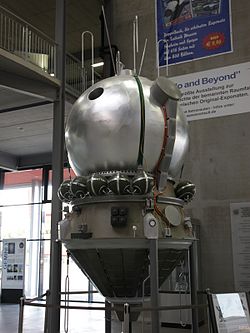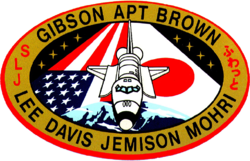STS-46
| STS-46 | |||||
 | |||||
| Uppdrag | 49 | ||||
|---|---|---|---|---|---|
| Rymdfärja | Atlantis (12)[1] | ||||
| NSSDC-ID | 1992-049A[2] | ||||
| Färdens tid | 7 dagar, 23 timmar, 15 minuter, 3 sekunder | ||||
| Uppskjutning | |||||
| Startplats | Startplatta 39A vid Kennedy Space Center i Florida | ||||
| Start | 31 juli 1992, 9:56:48 a.m. EDT | ||||
| Landning | |||||
| Landningsplats | Runway 33, KSC | ||||
| Landning | 8 augusti 1992, 9:11:50 a.m. EDT | ||||
| Omloppsbana | |||||
| Varv | 126 st[3] | ||||
| Apogeum | 437 km | ||||
| Perigeum | 425 km | ||||
| Banlutning | 28,45° | ||||
| Sträcka | 5,344 miljoner km | ||||
| Besättning | |||||
| Befälhavare | Loren J. Shriver (3) | ||||
| Pilot | Andrew M. Allen (1) | ||||
| Uppdragsspecialister | Jeffrey A. Hoffman (3) Franklin R. Chang-Diaz (3) Claude Nicollier (1) ESA Marsha S. Ivins (2) | ||||
| Nyttolastspecialister | Franco Malerba (1) Italien | ||||
 | |||||
| Kronologi Rymdfärjeprogrammet | |||||
| |||||
STS-46 var den fyrtionionde flygningen i det amerikanska rymdfärjeprogrammet, den tolfte flygningen med rymdfärjan Atlantis. Den sköts upp från Pad 39A vid Kennedy Space Center i Florida den 31 juli 1992. Efter drygt fyra dagar i omloppsbana runt jorden återinträdde rymdfärjan i jordens atmosfär och landade vid Kennedy Space Center.
Se även
Referenser
- ^ NASA Space Shuttle Launch Archive Arkiverad 27 maj 2010 hämtat från the Wayback Machine., läst 28 juli 2016.
- ^ ”NASA Space Science Data Coordinated Archive” (på engelska). NASA. https://nssdc.gsfc.nasa.gov/nmc/spacecraft/display.action?id=1992-049A. Läst 19 mars 2020.
- ^ Manned Astronautics - Figures & Facts Arkiverad 4 mars 2016 hämtat från the Wayback Machine., läst 28 juli 2016.
Externa länkar
 Wikimedia Commons har media som rör STS-46.
Wikimedia Commons har media som rör STS-46.
| ||||||||
| ||||||||||||||||||||||||||||||||
Media som används på denna webbplats
Författare/Upphovsman: Pascal (Flickr user: pasukaru76), Licens: CC0
Vostok spacecraft replica at the Technik Museum Speyer, Germany.
STS-46 Mission Insignia
The STS-46 crew portrait includes 7 crew members. Seated in front (left to right) are Andrew M. Allen, pilot; and Loren J. Shriver, commander. Standing (left to right) are Marsha S. Ivins, mission specialist 4; Claude Nicollier, mission specialist 3; Jeffrey A. Hoffman, mission specialist 1; Franklin R. Chang-Diaz, mission specialist 2; and Franco Malerba, payload specialist 1. Launched aboard the Space Shuttle Atlantis on July 31, 1992 at 9:56:48 am (EDT), the mission's primary objectives included the deployment of the European Space Agency's European Retrievable Carrier (EURECA) and operation of the joint NASA/Italian Space Agency Tethered Satellite System (TSS).
The crew patch of STS-50, United States Microgravity Laboratory-One (USML-1), captures a Space Shuttle traveling above Earth while trailing the USML banner. The Orbiter is oriented vertically in a typical attitude for microgravity science and in this position represents the numeral 1 in the mission's abbreviated title. This will be the first in a series of USML flights where the primary objective is microgravity science, planned and executed through the combined efforts of our country's government, industry, and academia.
Visible in the orbiter's payload bay are the Spacelab module, and the extended duration Orbiter "cryo" pallet which is being flown for the first time on STS-50. The small g and Greek letter mu on the Spacelab module symbolize the microgravity environment being used for research in the areas of materials science and fluid physics. The large block letter U extends outside of the patch's perimeter, symbolizing the potential for the experiments on this flight to expand the current boundaries of knowledge in microgravity science.
The Stars and Stripes of the USML block letter and the U.S. landmass visible in the Earth scene below the Orbiter reflect the crew's pride in the United States origin of all on-board experiments.The mission emblem of STS-47 depicts the Space Shuttle Orbiter with the Spacelab module in the cargo bay against a backdrop of the flags of the United States and Japan, symbolizing the side-by-side cooperation of the two nations in this mission. The land masses of Japan and Alaska are represented on the emblem emphasizing the multi-national aspect of the flight as well as the high inclination orbit of 57 degrees. The initials `SLJ' on the left border of the emblem stand for Spacelab Japan, but the name generally used for the mission is `Spacelab-J.' The Japanese characters on the right border form the word `Fuwatto' which is the Japanese word for weightlessness.






